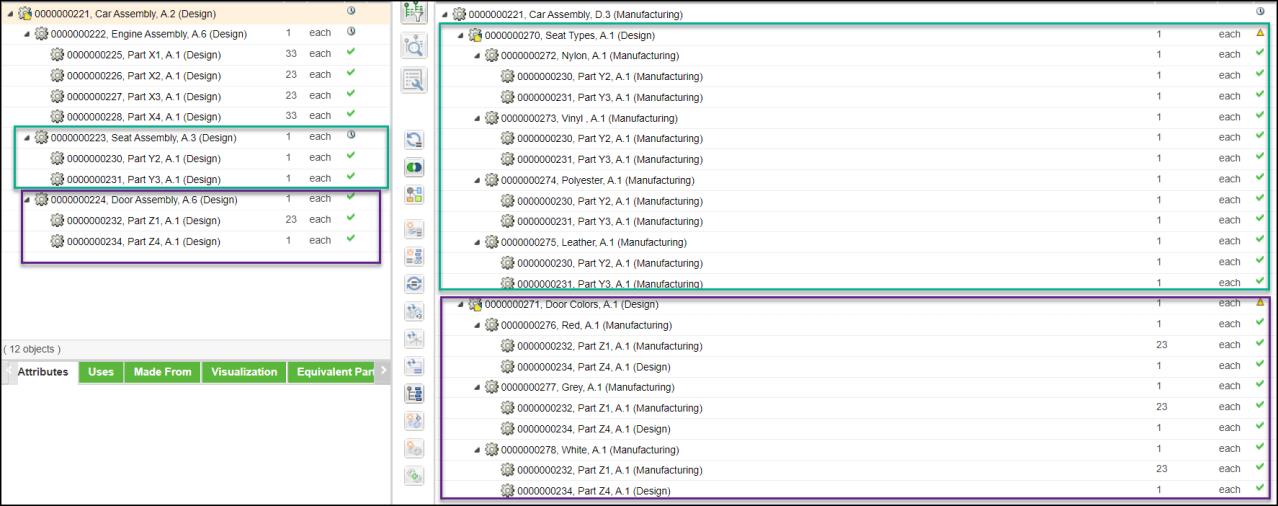About Assemble Action in BOM Transformer
You can use the Assemble action in an upstream view of BOM Transformer to create multiple alternate assemblies in downstream view from existing assemblies in the upstream view.
A manufacturing engineer can use this action to create multiple alternate assemblies in the downstream view with diverse colors, materials, and so on. The Assemble action enables you to efficiently manage multi-BOMs. While using the Assemble action, you can choose the way in which the child parts are consumed in the downstream view. Refer the video for more details. To view the video in a larger window, click on the video title. This opens the video in YouTube in a new tab.
Consider the following two use cases:
Use case 1
A design engineer creates a car door assembly in an upstream view, and a manufacturing engineer can use theAssemble action to create alternate car door assemblies in Red, White, and Gray colors in downstream.
Use case 2
A design engineer creates a car seat assembly in an upstream view and a manufacturing engineer can use the Assemble action to create alternate car seat fabric assembly with Nylon, Leather, Polyester, and Vinyl material.

Key Points
• An assembly in the upstream view and its alternate assemblies in the downstream view are considered a set. For example, the assemblies marked in green is considered as one set and the assemblies marked in indigo is considered as another set.
You can also select multiple assemblies in the upstream view to create alternate assemblies in downstream view. In this case, the multiple assemblies in the upstream view and the alternate assemblies in downstream view is considered as a set.
• In a set, an alternate equivalent link exists between the selected assemblies in the upstream view and its alternate assemblies in the downstream view.
Examples:
◦ For the set marked with green, an alternate equivalent link exists between the Seat Assembly part in the upstream view and Nylon part in the downstream view.
◦ For the set marked with green, an alternate equivalent link exists between the Seat Assemblypart in the upstream view and Vinyl part in the downstream view.
• In a set, an equivalent link exists between the child parts of the assembly in the upstream view and the child parts of the alternate assemblies in the downstream view.
• The assemblies in the downstream view are mutually exclusive of each other.
• Consider that an assembly A is present in upstream. Alternate assemblies B, C, and D are created from A using the Assemble action. After creation of the alternate assemblies, changes were made in the assembly A present in upstream. These changes can be incorporated in the alternate assemblies B, C, and D by using the Update to Current Equivalent Objects,  Detect Discrepancies, or
Detect Discrepancies, or  Synchronize Structures action.
Synchronize Structures action.
 Detect Discrepancies, or
Detect Discrepancies, or  Synchronize Structures action.
Synchronize Structures action.Use the  icon in the Update to Current Equivalent Objects, Review and Resolve Discrepancies, or Synchronize Structures dialog box to resolve discrepancies with status as Interactive or Auto. For more information, refer
icon in the Update to Current Equivalent Objects, Review and Resolve Discrepancies, or Synchronize Structures dialog box to resolve discrepancies with status as Interactive or Auto. For more information, refer
 icon in the Update to Current Equivalent Objects, Review and Resolve Discrepancies, or Synchronize Structures dialog box to resolve discrepancies with status as Interactive or Auto. For more information, refer
icon in the Update to Current Equivalent Objects, Review and Resolve Discrepancies, or Synchronize Structures dialog box to resolve discrepancies with status as Interactive or Auto. For more information, refer